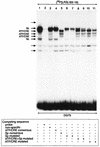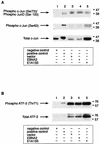An ATF/CRE element mediates both EBNA2-dependent and EBNA2-independent activation of the Epstein-Barr virus LMP1 gene promoter
- PMID: 9445037
- PMCID: PMC124615
- DOI: 10.1128/JVI.72.2.1365-1376.1998
An ATF/CRE element mediates both EBNA2-dependent and EBNA2-independent activation of the Epstein-Barr virus LMP1 gene promoter
Abstract
The Epstein-Barr virus (EBV) latent membrane protein 1 (LMP1) is a viral oncogene whose expression is regulated by both viral and cellular factors. EBV nuclear antigen 2 (EBNA2) is a potent transactivator of LMP1 expression in human B cells, and several EBNA2 response elements have been identified in the promoter regulatory sequence (LRS). We have previously shown that an activating transcription factor/cyclic AMP response element (ATF/CRE) site in LRS is involved in EBNA2 responsiveness. We now establish the importance of the ATF/CRE element by mutational analysis and show that both EBNA2-dependent activation and EBNA2-independent activation of the promoter occur via this site but are mediated by separate sets of factors. An electrophoretic mobility shift assay (EMSA) with specific antibodies showed that the ATF-1, CREB-1, ATF-2 and c-Jun factors bind to the site as ATF-1/CREB-1 and ATF-2/c-Jun heterodimers whereas the Sp1 and Sp3 factors bind to an adjacent Sp site. Overexpression of ATF-1 and CREB-1 in the cells by expression vectors demonstrated that homodimeric as well as heterodimeric forms of the factors transactivate the LMP1 promoter in an EBNA2-independent manner. The homodimers of ATF-2 and c-Jun did not significantly stimulate promoter activity. In contrast, the ATF-2/c-Jun heterodimer had only a minor stimulatory effect in the absence of EBNA2 but induced a strong transactivation of the LMP1 promoter when coexpressed with this protein. Evidence for a direct interaction between the ATF-2/c-Jun heterodimeric complex and EBNA2 was obtained by EMSA and coimmunoprecipitation experiments. Thus, our results suggest that EBNA2-induced transactivation via the ATF/CRE site occurs through a direct contact between EBNA2 and an ATF-2/c-Jun heterodimer. EBNA2-independent promoter activation via this site, on the other hand, is mediated by a heterodimeric complex between the ATF-1 and CREB-1 factors.
Figures










Similar articles
-
PU box-binding transcription factors and a POU domain protein cooperate in the Epstein-Barr virus (EBV) nuclear antigen 2-induced transactivation of the EBV latent membrane protein 1 promoter.J Gen Virol. 1995 Nov;76 ( Pt 11):2679-92. doi: 10.1099/0022-1317-76-11-2679. J Gen Virol. 1995. PMID: 7595375
-
Role of a consensus AP-2 regulatory sequence within the Epstein-Barr virus LMP1 promoter in EBNA2 mediated transactivation.Virus Genes. 2007 Oct;35(2):203-14. doi: 10.1007/s11262-007-0116-x. Epub 2007 Jun 2. Virus Genes. 2007. PMID: 17546492
-
Activity of the LMP1 gene promoter in Epstein-Barr virus-transformed cell lines is modulated by sequence variations in the promoter-proximal CRE site.J Gen Virol. 2007 Jul;88(Pt 7):1887-1894. doi: 10.1099/vir.0.82771-0. J Gen Virol. 2007. PMID: 17554019
-
Both Epstein-Barr viral nuclear antigen 2 (EBNA2) and activated Notch1 transactivate genes by interacting with the cellular protein RBP-J kappa.Immunobiology. 1997 Dec;198(1-3):299-306. doi: 10.1016/s0171-2985(97)80050-2. Immunobiology. 1997. PMID: 9442401 Review.
-
Regulation of Hepatic Metabolism and Cell Growth by the ATF/CREB Family of Transcription Factors.Diabetes. 2021 Mar;70(3):653-664. doi: 10.2337/dbi20-0006. Diabetes. 2021. PMID: 33608424 Free PMC article. Review.
Cited by
-
The latent membrane protein 1 (LMP1) oncogene of Epstein-Barr virus can simultaneously induce and inhibit apoptosis in B cells.J Virol. 2012 Apr;86(8):4380-93. doi: 10.1128/JVI.06966-11. Epub 2012 Feb 8. J Virol. 2012. PMID: 22318153 Free PMC article.
-
Augmented latent membrane protein 1 expression from Epstein-Barr virus episomes with minimal terminal repeats.J Virol. 2010 Mar;84(5):2236-44. doi: 10.1128/JVI.01972-09. Epub 2009 Dec 16. J Virol. 2010. PMID: 20015988 Free PMC article.
-
Autoactivation of the Epstein-Barr virus oncogenic protein LMP1 during type II latency through opposite roles of the NF-kappaB and JNK signaling pathways.J Virol. 2006 Aug;80(15):7382-93. doi: 10.1128/JVI.02052-05. J Virol. 2006. PMID: 16840319 Free PMC article.
-
C-terminal region of EBNA-2 determines the superior transforming ability of type 1 Epstein-Barr virus by enhanced gene regulation of LMP-1 and CXCR7.PLoS Pathog. 2011 Jul;7(7):e1002164. doi: 10.1371/journal.ppat.1002164. Epub 2011 Jul 28. PLoS Pathog. 2011. PMID: 21857817 Free PMC article.
-
c-Myc Represses Transcription of Epstein-Barr Virus Latent Membrane Protein 1 Early after Primary B Cell Infection.J Virol. 2018 Jan 2;92(2):e01178-17. doi: 10.1128/JVI.01178-17. Print 2018 Jan 15. J Virol. 2018. PMID: 29118124 Free PMC article.
References
-
- Angel P, Karin M. The role of Jun, Fos and the AP-1 complex in cell-proliferation and transformation. Biochim Biophys Acta. 1991;1027:129–157. - PubMed
-
- Arany Z, Newsome D, Oldread E, Livingston D M, Eckner R. A family of transcriptional adaptor proteins targeted by the E1A oncoprotein. Nature. 1995;374:81–84. - PubMed
-
- Arias J, Alberts A S, Brindle P, Claret F X, Smeal T, Karin M, Feramisco J, Montminy M. Activation of cAMP and mitogen responsive genes relies on a common nuclear factor. Nature. 1994;370:226–229. - PubMed
Publication types
MeSH terms
Substances
LinkOut - more resources
Full Text Sources
Other Literature Sources
Research Materials
Miscellaneous

